
Ήταν ένα γεροντάκι που μόλις άκουγε τ’ όνομα της Παναγίας έκλαιγε σαν μικρό παιδί.
Ήταν ένας Καυσοκαλυβίτης που όποτε γύριζε πλευρό τη νύχτα έψελνε το «Άξιον εστί».
Ήταν ένας Γρηγοριάτης ηγούμενος πού ΄χε «φάει» την εικόνα Της από τους πολλούς ασπασμούς.
Ήταν ένας Νεοσκητιώτης που παρακαλούσε όποιον έβλεπε να μιλήσει, να γράψει, να εκδώσει, ότι υπήρχε για την Παναγία.
Ήταν ένας μακαρίτης Ιβηρίτης που έπασχε από αγάπη προς την Πορταΐτισσα.
Ένας Φιλοθεΐτης έλεγε: «Έχομεν βεβαίας τας ελπίδας εις την Γλυκοφιλούσαν»
Παναγία· η μάνα των Αγιορειτών.
Η Παναγία. Πάνω απ’ όλες τις αγίες. Μητέρα Θεού και ανθρώπων. Η καλύτερη παραμυθία. Η πιο σίγουρη πρέσβειρα των πιστών. Η πιο ταπεινή, η πιο καλή, η πιο σεμνή, η πιο υπάκουη, η πιο υπομονετική, η σιωπηλή, η γενναία, η πρώτη, η βασίλισσα, η Κυρία, η Έφορος, η Οικονόμισσα, η φωτοφόρος νεφέλη και μανναδόχος στάμνα.
Χαρά να την αντικρύσεις. Ευχαρίστηση να την επικαλείσαι. Ευλογία να σ’ επισκέπτεται. Ελπίδα βέβαιη να την παρακαλάς. Βοήθεια μεγάλη η σκέπη της.
Που να βρεις τα ωραία λόγια να την εγκωμιάσεις; Πόσο φτωχή είναι η γλώσσα για τα μεγάλα ονόματα; Πόσο έχει φθαρεί η γλώσσα από την κατάχρηση. Έτσι σιωπάς και τα λες όλα. Όπως σιωπηλή ακολουθούσε παντού τον αγαπητό Υιό Της. Μέχρι Σταυρού.
Αθωνίτισσα Θεοτόκε, το ακοίμητο κανδήλι, το αγνό κερί, οι Χαιρετισμοί, η Παράκληση, το Θεοτοκάριο, τα Θεοτόκια δεν σου αρκούν. Μήτε γονυκλισίες και τάματα και προσφορές και κομποσχοίνια. Την καθαρότητα της καρδίας ζητάς για νάλθει ο Υιός σου να κατοικήσει και να φέρει θεοτόκες και θεοφόρες ώρες αγίας θεοψίας και φωτοχυσίας…
Μητέρα του Θεού, μητέρα των ανθρώπων, μητέρα του πόνου, μητέρα της αγωνίας, μητέρα των θλιβομένων, σύντροφε των μονομάχων του Θεού, των καλογέρων.
Όπως και να το κάνουμε είναι ανώτερες ψυχές οι Αγιορείτες, αφού επέλεξαν ν’ αφοσιωθούν μόνιμα στην Αθωνίτισσα Θεοτόκο.
Υπεραγία Θεοτόκε σώσον ημάς· του Άξιον εστί του πάνσεπτου ναού του Πρωτάτου της πρωτεύουσας των Καρυών, της Κουκουζέλισσας της Μεγίστης Λαύρας, της Βατοπεδινής Εσφαγμένης, της Πορταΐτισσας των Ιβήρων, της Τριχερούσης του Χιλιανδαρίου, του Ακαθίστου της Διονυσίου, της Φοβεράς Προστασίας του Κουτλουμουσίου, της Γερόντισσας του Παντοκράτορος, της Γοργοϋπηκόου της Δοχειαρίου, της Μυροβλύτισσας του Αγίου Παύλου, της Οδηγήτριας του Ξενοφώντος και τόσες άλλες, σ’ εκκλησίες και παρεκκλήσια, κελλιά και καλύβια...
Από το βιβλίο «Αθωνικό απόδειπνο» του Μοναχού Μωϋσέως Αγιορείτου
http://agiameteora.net/
Saint George, the new martyr of Christ, lived in the city of Neapolis of Cappadocia (now Nev-Shekir in Turkey) in the eighteenth century. He was a priest at the Church of the Dormition of the Theotokos and served his flock with righteousness and holiness as a true servant of the Most-high. Gifted with the qualities of love and meekness, brotherly love and forbearance, humble and spotless was his support and consolation of the Greek Christians who then lived under the yoke of the Turks. As an angel on earth the divine George willingly served his fellow men cultivating the divine gifts and pleasing to God.
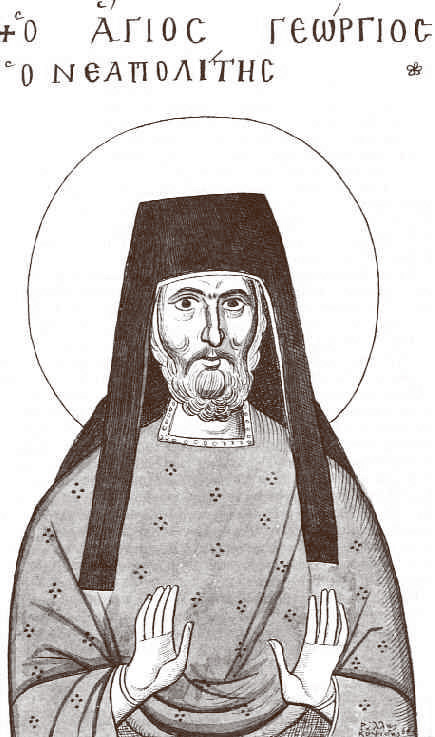
In the year 1797 he was invited to the village Malakopi, located within six hours from Neapolis, to serve at some great feast and to bless their pious Christians, because their priest was ill, and or, in the opinion of others, was hiding from the fury of the Turks. The elder George now gladly accepted the invitation without considering the suffering and above all the risks.
Mounting his shabby donkey, he proceeded willing. He approached close to Malakopi, when suddenly at “Kobia Dere “, meaning “ravine”, he experienced a wild attack of Turkish shepherds, who angrily fell on him with an indescribable fury. They robbed him they stripped him naked, and in the end they gave him a martyric death, cutting off his precious head. His body, naked and bloodied, with his head they left in an adjacent canyon, but his soul flew close to its Lord to be numbered among the Righteous and the Hieromartyrs.
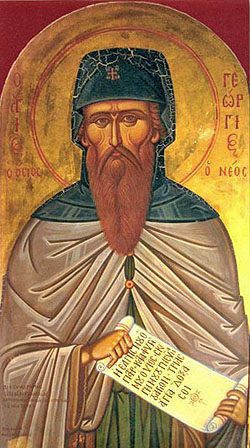 Four days passed without the Holy priest reaching Malakopi, but also not returning to Neapolis. Concerned citizens of Neapolis went in search of him. They found his holy body and his precious head and lamenting and weeping at his difficult death, a shepherd hastily buried him, fearing the fury of Turks. Above his grave a stone bore the simple inscription: “The Priest George”.
Four days passed without the Holy priest reaching Malakopi, but also not returning to Neapolis. Concerned citizens of Neapolis went in search of him. They found his holy body and his precious head and lamenting and weeping at his difficult death, a shepherd hastily buried him, fearing the fury of Turks. Above his grave a stone bore the simple inscription: “The Priest George”.
Some time passed, until one night the holy hieromartyr appeared in a vision to a pious widow relating to her what happened and urging her to inform the Mayor to look to find the location in which he was buried. The woman did not give importance to it, but when after a few days the dream was repeated, she was fearful and did what the saint asked. Without delay the pious citizens of Neapolis led by a priest, called Neophytos, son also of priest Basilios, the fellow priest of Church of the Dormition, hastened and excavated the grave. Oh, the miracle! The relic of the Saint remained whole and incorrupt spreading heavenly fragrance and Grace! After they venerated it with reverence and awe, they placed in a wooden casket and carried it to the home of Fr. Neophytos, according to the desire of the Saint himself, and kept it in a cell.
There many came, locals and foreigners, to venerate the Saint and receive blessing from his venerable relic. Miracles began to occur: the sick and disabled were healed, childless couples bore children, spiritual illnesses disappeared, and further during drought the citizens of Neapolis fled to the Saint, that they might shortly see the blessed rain fall strongly. All confessed how miraculous St. George was shown to be!
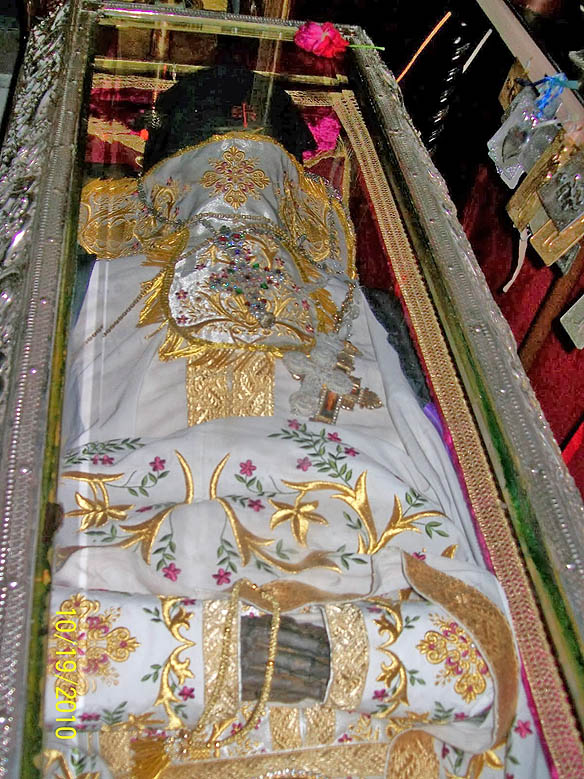
The Holy and Incorrupt Relics of St. George of Neapolis. Church of St. Eustathios, Perissos (Attiki)
In 1924, with the exchange of populations, the Greeks of Cappadocia left for free Greece, each taking with him whatever he considered most precious. The then priest of the Church of the Dormition of the Theotokos archimandrite Ignatios, perceiving his first responsibility to safely transfer the miraculous and incorrupt relic of St. George, brought it from the shore of Mersinis by steamer to Attica. During the journey they had very rough seas, but they were lulled with a miracle of the Saint.
In Attica the sacred relic was handed over to citizens of Neapolis, who placed it with reverence in the Church of St. Eustathios in New Neapolis, Perissos. Since then countless are the miracles and the healings which St. George worked to those who call on his name with faith.
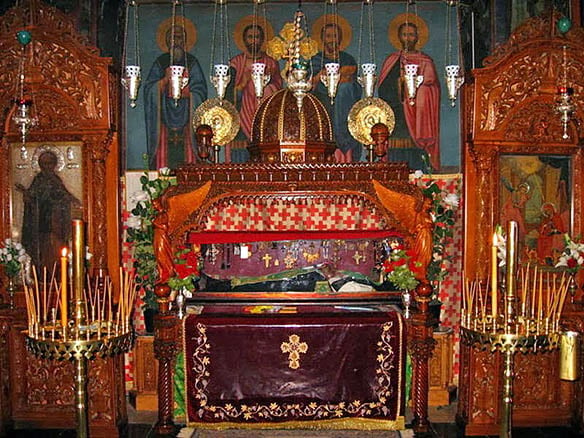
The Reliquary containing the Holy and Incorrupt Relics of St. George of Neapolis, treasured by the Church of St. Eustathios, Nea Neapolis, Perissos (Attiki)
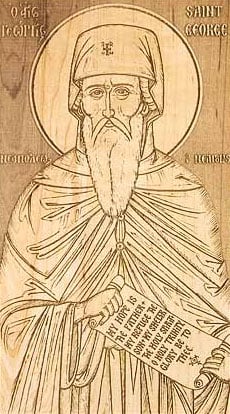 Apolytikion in the Fourth Tone
Apolytikion in the Fourth Tone
As a sharer of the ways and a successor to the throne of the Apostles, O inspired of God, thou foundest discipline to be a means of ascent to divine vision. Wherefore, having rightly divided the word of truth, thou didst also contest for the Faith even unto blood, O Hieromartyr George. Intercede with Christ our God that our souls be saved.
Through the prayers of New Martyr George of Neapolis, Lord Jesus Christ our God, have mercy on us and save us! Amen!
Source: full-of-grace-and-truth.blogspot.com



 Four days passed without the Holy priest reaching Malakopi, but also not returning to Neapolis. Concerned citizens of Neapolis went in search of him. They found his holy body and his precious head and lamenting and weeping at his difficult death, a shepherd hastily buried him, fearing the fury of Turks. Above his grave a stone bore the simple inscription: “The Priest George”.
Four days passed without the Holy priest reaching Malakopi, but also not returning to Neapolis. Concerned citizens of Neapolis went in search of him. They found his holy body and his precious head and lamenting and weeping at his difficult death, a shepherd hastily buried him, fearing the fury of Turks. Above his grave a stone bore the simple inscription: “The Priest George”. 

 Apolytikion in the Fourth Tone
Apolytikion in the Fourth Tone